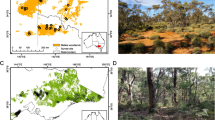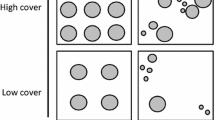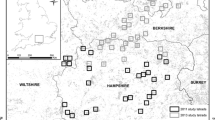Abstract
Accurate a priori predictions of the sensitivity of species to vegetation management depend on an understanding of mechanisms underlying species response. To date information on where birds forage in the vegetation strata has been used to predict bird species response to vegetation change caused by livestock grazing. Profiting from this link between vegetation structural diversity and bird diversity, we test whether this variable, bird foraging height, can be used to predict the impact of a different type of habitat alteration; vegetation encroachment. Increases in vegetation density, called ‘encroachment’ or ‘thickening’, throughout savanna landscapes are considered a serious management issue for pastoral activities and a potential threat to biodiversity. We developed woody-vegetation-change models to predict the effect of vegetation encroachment on bird species through an understanding of where birds forage in intact vegetation communities. We compare model predictions with bird abundance data collected from 60 field sites representing a single woodland vegetation type, but with a gradient of woody vegetation density caused by clearing, thinning and natural climatic perturbation. Our model successfully predicted for the majority (80%) of birds considered, whether a species was likely to increase, decrease or remain unaffected by increases in woody vegetation density. We find that the majority of species respond positively to vegetation encroachment. Our approach avoids problems of post hoc data interpretation and tests a specific mechanism underlying bird species response to habitat alteration, bird foraging height. Simple predictive models such as these will assist land managers make informed decisions about management actions and consequences, particularly in cases where decisions need to be made urgently and preclude the collection and analysis of primary ecological data sets.

Similar content being viewed by others
References
Archer SR (1995) Tree-grass dynamics in a Prosopis-thornscrub savanna parkland: reconstructing the past and predicting the future. Ecoscience 2:83–99
Barrett G, Silcocks A, Barry S, Cunningham R, Poulter R (2003) The new Atlas of Australian birds. Royal Australasian Ornithologists Union, Melbourne
Blaum N, Rossmanith E, Popp A, Jeltsch F (2007) Shrub encroachment affects mammalian carnivore abundance and species richness in semiarid rangelands. Acta Oecol Int J Ecol 31:86–92
Bond WJ, Midgley GF, Woodward FI (2003) The importance of low atmospheric CO2 and fire in promoting the spread of grasslands and savannas. Glob Chang Biol 9:973–982
Bowman DMJS, Walsh A, Milne DJ (2001) Forest expansion and grassland contraction within a Eucalyptus savanna matrix between 1941 and 1994 at Litchfield National Park in the Australian monsoon tropics. Glob Ecol Biogeogr 10:535–548
Bucini G, Hanan NP (2007) A continental-scale analysis of tree cover in African savannas. Glob Ecol Biogeogr 16:593–605
Burrows WH (2002) Harry Stobbs Memorial Lecture, 2002. Seeing the wood(land) for the trees—an individual perspective of Queensland woodland studies (1965–2005). Trop Grassl 36:202–217
Burrows WH, Scanlan JC, Rutherford M (eds) (1988) Native pastures in Queensland. Their resources and management. Department of Primary Industries, Queensland Government, Brisbane
Christidis L, Boles WE (1994) The taxonomy and species of birds of Australia and its territories. Royal Australasian Ornithologists Union, Melbourne
Coppedge BR, Engle DM, Masters RE, Gregory MS (2004) Predicting juniper encroachment and CRP effects on avian community dynamics in southern mixed-grass prairie, USA. Biol Conserv 115:431–441
Fensham RJ (2008a) Leichhardt’s maps: 100 years of change in vegetation structure in inland Queensland. J Biogeogr 35:141–156
Fensham RJ (2008b) A protocol for assessing applications to selectively clear vegetation in Australia. Land Use Policy 25:249–258
Fensham RJ, Fairfax RJ (2002) Aerial photography for assessing vegetation change: a review of applications and the relevance of findings for Australian vegetation history. Aust J Bot 50:415–429
Fensham RJ, Fairfax RJ (2003) Assessing woody vegetation cover change in north-west Australian savanna using aerial photography. Int J Wildland Fire 12:359–367
Fensham RJ, Fairfax RJ, Archer SR (2005) Rainfall, land use and woody vegetation cover change in semi-arid Australian savanna. J Ecol 93:596–606
Fischer J, Lindenmayer DB (2006) Beyond fragmentation: the continuum model for fauna research and conservation in human-modified landscapes. Oikos 112:473–480
Ford HA, Barrett GW, Saunders DA, Recher HF (2001) Why have birds in the woodlands of Southern Australia declined? Biol Conserv 97:71–88
Garnett ST, Crowley GM (1995) Recovery plan for the Golden-shouldered Parrot. Queensland Department of Environment and Heritage, Cairns
Graves GR, Gotelli NJ (1983) Neotropical land-bridge avifaunas: new approaches to null hypotheses in biogeography. Oikos 41:322–333
Higgins PJ (ed) (1999) Handbook of Australian, New Zealand and Antarctic birds. Volume 4: Parrots to Dollarbird. Oxford University Press, Melbourne
Higgins PJ, Davies SJJF (eds) (1996) Handbook of Australian, New Zealand and Antarctic Birds. Volume 3: Snipe to Pigeons. Oxford University Press, Melbourne
Higgins PJ, Peter JM (eds) (2002) Handbook of Australian, New Zealand and Antarctic Birds. Volume 6: Pardalotes to Shrike-thrushes. Oxford University Press, Melbourne
Higgins SI, Bond WJ, Trollope WSW (2000) Fire, resprouting and variability: a recipe for grass-tree coexistence in savanna. J Ecol 88:213–229
Higgins PJ, Peter JM, Steele WK (eds) (2001) Handbook of Australian, New Zealand and Antarctic Birds. Volume 5: Tyrant-flycatchers to Chats. Oxford University Press, Melbourne
Higgins PJ, Peter JM, Cowling SJ (eds) (2006a) Handbook of Australian, New Zealand and Antarctic Birds. Volume 7: Boatbills to Starlings. Part A: Boatbill to Larks. Oxford University Press, Melbourne
Higgins PJ, Peter JM, Cowling SJ (eds) (2006b) Handbook of Australian, New Zealand and Antarctic Birds. Volume 7: Boatbills to Starlings. Part B: Dunnock to Starlings. Oxford University Press, Melbourne
Kissling WD, Field R, Böhning-Gaese K (2008) Spatial patterns of woody plant and bird diversity: functional relationships or environmental effects? Glob Ecol Biogeogr 17:327–339
Kutt AS, Woinarski JCZ (2007) The effects of grazing and fire on vegetation and the vertebrate assemblage in a tropical savanna woodland in north-eastern Australia. J Trop Ecol 23:95–106
Lindenmayer DB, McIntryre S, Fischer J (2003) Birds in Eucalypt and pine forest: landscape alteration and its implications for research models of faunal habitat use. Biol Conserv 110:45–53
Mac Nally R, Bennett AF, Horrocks G (2000) Forecasting the impacts of habitat fragmentation. Evaluation of species-specific predictions of the impact of habitat fragmentation on birds in the box-ironbark forests of central Victoria, Australia. Biol Conserv 95:7–29
Mac Nally R, Horrocks G, Pettifer L (2002) Experimental evidence for potential beneficial effects of fallen timber in forests. Ecol Appl 12:1588–1594
MacArthur RH, Recher HF, Cody M (1966) On the relation between habitat selection and species diversity. Am Nat 100:319–332
Marchant S, Higgins PJ (eds) (1990a) Handbook of Australian, New Zealand and Antarctic birds. Volume 1: Ratites to Ducks. Part A: Ratites to Petrels. Oxford University Press, Melbourne
Marchant S, Higgins PJ (eds) (1990b) Handbook of Australian, New Zealand and Antarctic birds. Volume 1: Ratites to Ducks. Part B: Pelican to Ducks. Oxford University Press, Melbourne
Marchant S, Higgins PJ (eds) (1993) Handbook of Australian, New Zealand and Antarctic Birds. Volume 2: Raptors to Lapwings. Oxford University Press, Melbourne
Martin TG, McIntye S (2007) Impacts of livestock grazing and tree clearing on birds of woodland and riparian habitats. Conserv Biol 21:504–514
Martin TG, Possingham HP (2005) Predicting the impact of livestock grazing on birds using foraging height data. J Appl Ecol 42:400–408
Martin TG, McIntyre S, Catterall CP, Possingham HP (2006) Is landscape context important for riparian conservation? Birds in grassy woodland. Biol Conserv 127:201–214
McAlpine CA, Fensham RJ, Temple-Smith DE (2002) Biodiversity conservation and vegetation clearing in Queensland: principles and thresholds. Rangel J 24:36–55
Prins HHT, Vanderjeugd HP (1993) Herbivore population crashes and woodland structure in East-Africa. J Ecol 81:305–314
Recher HF (1969) On the relation of birds and habitat in Australia and North America. Am Nat 103:75–79
Recher HF, Holmes RT (2000) The foraging ecology of birds of eucalypt forest and woodland. I. Differences between males and females. Emu 100:205–215
Recher HF, Kavanah JM, Shields JM, Linds P (1991) Ecological associations of birds and habitats during the breeding season in south-eastern New South Wales. Aust J Ecol 16:337–352
Rosenstock SS, Anderson DR, Giesen KM, Leukering T, Carter MF (2002) Landbird counting techniques: current practices and an alternative. Auk 119:46–53
Sattler P, Williams R (1999) The conservation status of Queensland’s bioregional ecosystems. Environmental Protection Agency, Brisbane
Scholes RJ, Archer SR (1997) Tree-grass interactions in savannas. Annu Rev Ecol Syst 28:517–544
Sharp BR, Whittaker RJ (2003) The irreversible cattle-driven transformation of a seasonally flooded Australian savanna. J Biogeogr 30:783–802
Tassicker AL, Kutt AS, Vanderduys E, Mangru S (2006) The effects of vegetation structure on the birds in a tropical savanna woodland in north-eastern Australia. Rangel J 28:139–152
Thomson JR, Mac Nally R, Fleishman E, Horrocks G (2007) Predicting bird species distributions in reconstructed landscapes. Conserv Biol 21:752–766
Van Auken OW (2000) Shrub invasions of North American semiarid grasslands. Annu Rev Ecol Syst 31:197–215
Whelan CJ (2001) Foliage structure influences foraging of insectivorous forest birds: an experimental study. Ecology 82:219–231
Wiegand K, Saltz D, Ward D (2006) A patch-dynamics approach to savanna dynamics and woody plant encroachment—insights from an arid savanna. Perspect Plant Ecol Evol Syst 7:229–242
Wiens JA (1989) The ecology of bird communities. Part 1. Cambridge University Press, Cambridge
Witt GB, Luly J, Fairfax RJ (2006) How the west was once: vegetation change in south-west Queensland from 1930 to 1995. J Biogeogr 33:1585–1596
Woinarski JCZ, Catterall CP (2004) Historical changes in the bird fauna at Coomooboolaroo, northeastern Australia, from the early years of pastoral settlement (1873) to 1999. Biol Conserv 116:379–401
Woinarski JCZ, Tidemann SC (1991) The bird fauna of a deciduous woodland in the wet-dry tropics of northern Australia. Wildl Res 18:479–500
Woinarski JCZ, Brock C, Armstrong M, Hempel C, Cheal DC, Brennan K (2000) Bird distribution in riparian vegetation in the extensive natural landscape of Australia’s tropical savanna: a broad-scale survey and analysis of a distributional data base. J Biogeogr 27:843–868
Woinarski JCZ, Risler J, Kean L (2004) Response of vegetation and vertebrate fauna to 23 years of fire exclusion in a tropical Eucalyptus open forest, Northern Territory, Australia. Austral Ecol 29:156–176
Acknowledgements
We are grateful for the help of numerous landholders in granting us access to their properties for the survey: the Bode’s (Woura Park and Timaru), Haydon’s (Penrice) and Merten’s (Kalleroo). Adam Tassicker (James Cook University), Eric Vanderduys (CSIRO Sustainable Ecosystems) provided valuable assistance with the fieldwork. This project was funded by the Tropical Savannas CRC, CSIRO Sustainable Ecosystems and the Australian Government Natural Heritage Trust (ASK) and NSERC (TGM). The manuscript was improved through comments by two anonymous referees.
Author information
Authors and Affiliations
Corresponding author
Rights and permissions
About this article
Cite this article
Kutt, A.S., Martin, T.G. Bird foraging height predicts bird species response to woody vegetation change. Biodivers Conserv 19, 2247–2262 (2010). https://doi.org/10.1007/s10531-010-9840-y
Received:
Accepted:
Published:
Issue Date:
DOI: https://doi.org/10.1007/s10531-010-9840-y




